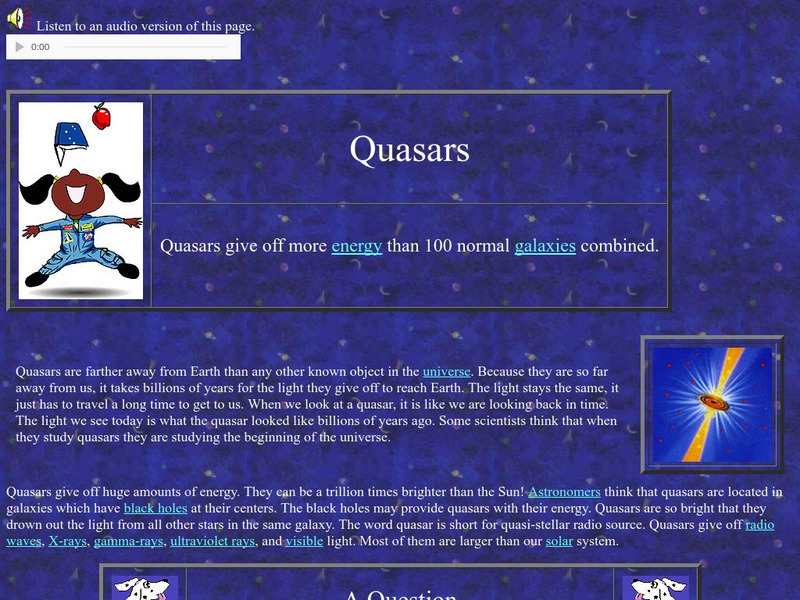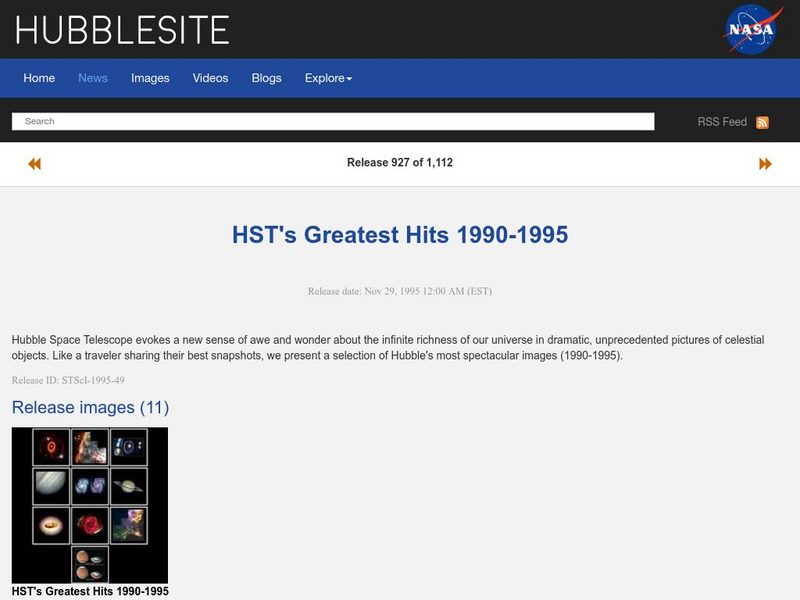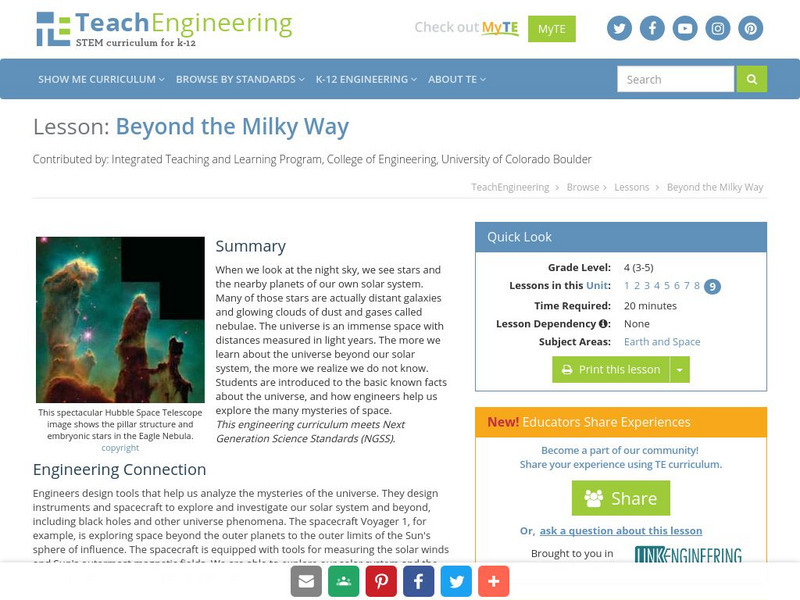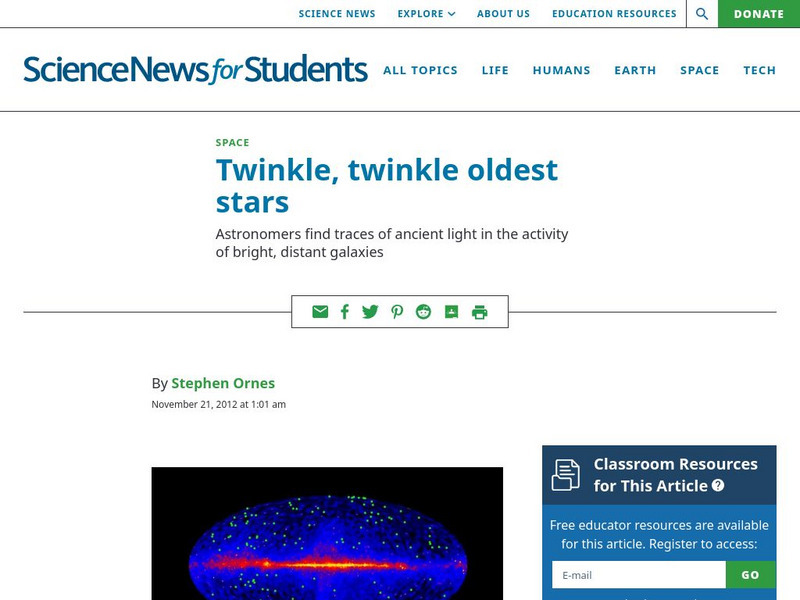Curated OER
Science Kids: Science Images: Universe Timeline
This diagram shows a universe timeline as suggested by many scientists and theoretical physics experts. This popular timeline of the universe has different stages which include: quantum fluctuations, inflation, dark ages, first stars,...
Curated OER
Astro Lab: Space, a Contemporary Vision of the Universe
Explore how our contemporary understanding of the universe came to be. This overview looks at the history of three main areas of study, namely space, time, and the arrangement of matter.
Curated OER
Astro Lab: Space, a Contemporary Vision of the Universe
Explore how our contemporary understanding of the universe came to be. This overview looks at the history of three main areas of study, namely space, time, and the arrangement of matter.
Curated OER
Astro Lab: Space, a Contemporary Vision of the Universe
Explore how our contemporary understanding of the universe came to be. This overview looks at the history of three main areas of study, namely space, time, and the arrangement of matter.
BBC
Bbc: Dark Matter
A clear explanation of how dark matter was discovered and why it is important to astronomers.
Other
Sky Server: About Astronomy
This site from SkyServer provides the history of astronomy as well as links to mapping the sky, galaxies, cosmic structures and much more. Several pictures are given, and the article is medium in length.
National Institute of Educational Technologies and Teacher Training (Spain)
Ministerio De Educacion: La Situacion De La Tierra en El Universo
Throughout this unit you will make an imaginary journey that will transport you from the remotest infinity of the universe around us, to the surface of our planet. During this trip you will see the main features and components of our...
Space Telescope Science Institute
Amazing Space: Hubble Deep Field Academy
At this site, students can become a Steller Statistician, Cosmic Classifier, Galactic Guide or a Universal Graduate by attending the Hubble Deep Field Academy--and entering information in their Hubble Academy Log (HAL), which is assessed...
NASA
Nasa: Space Place: What Is the Big Bang?
With exciting illustrations, NASA's Space Place explains the theory of the origin of the universe known as the Big Bang.
NASA
Nasa Star Child: Quasars (Level 1)
Learn why quasars are the brightest things in the universe. Vocabulary words linked to a glossary of terms and a printable version are available.
NASA
Nasa: Imagine the Universe: "Nasa Detects One of Closest"
Site provides the article, "NASA Detects One Of Closest And Brightest Gamma Ray Bursts." Provides links to learn more about gamma rays and black holes as well as other resources.
NASA
Nasa: Imagine the Universe: X Ray Binary Stars
Site provides a brief introduction to binary stars. Additional resources for students and teachers on this topic are offered as well as related topics.
Other
Paper Plate Education: Serving the Universe on a Paper Plate
Excellent resource for "paper-plate" activities that help simplify various astronomy topics. Learn how to build a "Moon Finder" and "Planet Pointer," and create a paper-plate model that explains the Transit of Venus.
NASA
Nasa: Wilkinson Microwave Anisotropy Probe (Wmap): The Milky Way
Description of the three major components of the Milky Way galaxy as well as images and resources for further reading.
Wikimedia
Wikipedia: The Black Hole
This site examines the black hole as an object in astrophysics. Delve into this comprehensive resource that covers this concept from its history, to qualitative physics, the reality of black holes, mathematical physics and more.
NASA
Nasa Star Child: Star Child
StarChild from NASA defines and describes the Solar System in a simple and easy-to-understand manner. The website is broken down into two versions for the student, grade school and junior high.
Chem4kids
Chem4 Kids: Chemistry in Space
Anywhere there is matter there is chemistry, therefore chemistry is found all over the universe, not only here on Earth. In fact, scientists have even discovered organic chemistry in other galaxies.
Curated OER
European Space Agency: Story of the Universe
The story of the universe is told in this engaging site by the European Space Agency. The history of European space science is timelined with dates ranging from 1066 to present day. The birth of galaxies, the big bang, and the beginnings...
Texas Education Agency
Texas Gateway: Introduction to Motion
What do you think of when you hear the word motion? Are you moving right now? You may not think so, but you are. Remember, the Earth is moving around the Sun, and the Sun is moving around the Milky Way Galaxy. Everything in the universe...
PBS
Pbs Learning Media: Solar System Scale Model
Teach the concept of scale models and the size of the solar system through this extensive lesson plan. Students will learn about scale models, estimate which objects to use to create a scale model of Earth and Sun, and figure out how far...
Space Telescope Science Institute
Space Telescope Science Institute: Hubble Site
Explore the universe and celestial phenomena made visible by Hubble. High-quality photos of planets, stars, nebulae, and galaxies, complete with individual descriptions, can be viewed online and downloaded for printing and personal use.
Space Telescope Science Institute
Hubble Space Photographs: Hst's Greatest Hits 1990 1995
Breathtaking images from the Hubble Space Telescope give a new perspective to our world.
TeachEngineering
Teach Engineering: Beyond the Milky Way
When we look at the night sky, we see stars and the nearby planets of our own solar system. Many of those stars are actually distant galaxies and glowing clouds of dust and gases called nebulae. The universe is an immense space with...
Society for Science and the Public
Science News for Students: Twinkle, Twinkle Oldest Stars
Astronomers have determined how super-bright galaxies can be used to detect the faint glow of "cosmic fog." Cosmic light is light that has left every star and now lingers in the universe, including light from stars that have burned out.
Other popular searches
- Galaxy Galaxies Universe
- Galaxies in the Universe
- The Universe and Galaxies
- Universe Galaxies Stars
- Galaxies and Universe



















